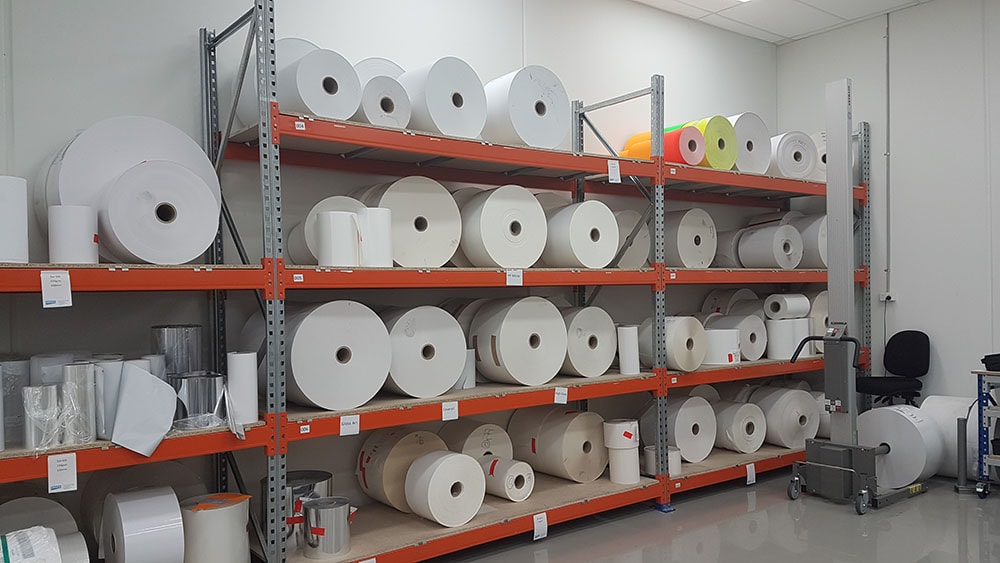No products
Substrate Guide
Selecting the right material
There are three elements that make up self-adhesive label substrate; face stock, adhesive and liner. Each of the materials in our range is made of a different combination.
When choosing the right label material there are many technical considerations, including:
- Application method
- What the label is being applied to
- Temperature conditions
- Life cycle of the product
- Branding requirements

Face Stock Options
Polypropylene labels
Polypropylene (PP) labels are a proven and widely used alternative to paper labels as they are waterproof and more durable. They are also used as an alternative to vinyl labels as they offer all the strengths of a synthetic material but have a lesser impact on the environment than vinyl and are recyclable through local government recycling programs.
Polyethylene labels
Polyethylene (PE) is a milky white synthetic film with light and flexible properties, unlike polypropylene it can stretch in all directions so it’s perfect for labelling products that expand and contract within the maximum operating temperature of 204°C. Polyethylene is useful for strong tamper evident seals.
Paper labels
Uncoated paper substrate provides excellent printability for a diverse range of industries – from retail and wine to pharmaceuticals and healthcare. It offers superior lay-flat properties for trouble-free printing and converting. Coated papers offer excellent printability for high-end graphics, coated paper face materials enhance the durability and longevity of the label, increasing resistance to challenging conditions such as humidity, heat or friction.
Direct Thermal labels (DT)
Direct thermal material has a chemical layer applied to the adhesive that is activated by heat. Direct thermal labels allow you to print variable information on the Pre-printed/blank labels
Thermals Transfer labels (TT)
Thermal transfer materials work slightly different to direct thermal. The variable data printing is transferred onto the label by way of Ribbon - this enables you to use a larger variety of material such as gloss paper and gloss polypropylenes. The print head elements heat up which then allows the ribbon to transfer onto the label surface.
Metallic labels
Metallic label stocks are a cost-effective substitute for a foil finish. This can be used for a wide variety of applications where a demanding label substrate is required, from water, food & beverage, household, chemical and point of sale label. Metallic substrate can be paper or synthetic.
Crystal Clear labels
Crystal Clear is a clear Polypropylene top coated film designed for label clarity with exceptional “no label” effect. Supplied with good stability to allow optimum print results and label performance giving the stock a cloud free/high resolution finish.
Adhesive Options
Hotmelt adhesive
Hot melt adhesives are generally rubber based adhesives that have an initial high tack. When pressure is applied to the adhesive and it is in contact with a surface, the adhesive will begin to “cure” and grip the surface it is applied to. The adhesive is softer compared to acrylic adhesives and as such can bleed into rough surfaces like recycled cardboard, to provide excellent adhesion on non-smooth surfaces. As they are rubber based they have poor resistance to high temperatures and UV light and as such should not be used outside for extended periods.
Acrylic adhesive
Acrylic adhesives are chemically different to hot melt adhesives and have good UV and heat resistant properties. When pressure is applied to the adhesive and it is in contact with a surface, the adhesive will have a lower initial tack compared to hot melt adhesive but over the next 24 hours the adhesion will grow to a high level. As the adhesive is not as soft as hot melt adhesive it does not perform as well on rough surfaces like recycled cardboard. Due to its harder composition, acrylic adhesives are more user friendly for conversion and application as the adhesive has less tendency to flow outside the edges of the label.
Removable adhesive
Removable adhesive creates a secure bond while still allowing the label to be removed without leaving any residue, tearing the label or damaging the surface. Removable labels offer a light, temporary fixing that can cope with the stresses of transportation and still be removed cleanly and easily. This adhesive clings firmly to both paper and film face materials, yet reposition easily and remove without a trace.
Freezer grade adhesive
Freezer grade label adhesive are the smart choice for a range of applications including meat packaging, medical products, cold beverage storage, and common packaging substrates used in freezer conditions.
Key Questions when considering a substrate selection
ADHESIVES
What type of adhesive?
e.g permanent or removable, hot melt or acrylic?
TEMPERATURE/CONDITIONS
On application
What are the labelling conditions when the label is applied?
e.g refrigerated, condensation, frozen or hot.
After application
What conditions will the label be exposed to after application?
e.g outdoor sunlight, moisture, chemical or heat (such as cooking).
APPLICATION
What surface is the label applied to?
e.g plastic, glass, cardboard or metal.
What is the surface shape and condition that the label will be applied?
e.g flat, round, small diameter or rough.
ADDITIONAL PRINTING PROCESS
Will there by an additional printing process by the customer?
e.g over printing by thermal transfer (ribbon), laser, ink jet or direct thermal.

